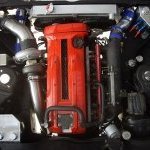BOV noise
Announcements
-
Similar Content
-
Latest Posts
-
If you get 12v at one of the relay pins with IGN on, and 12v at another for about 3 sec when you turn the key from ACC to start, then yes you can just earth the relay trigger pin. Just have a look at the top of the relay, it should tell you which pin needs earth when the 12v signal is sent (or if it's not clear, just post the pic and we can work it out). If you always have 12v at 2 pins with IGN on, they it is earth triggered by the ECU which makes it harder to fix (you really need to check the ECU pin is earthing when it should, and if so it is a wiring issue from there to the relay.
-
Got the gearbox in and the front drive shafts.
-
Hi There I went through a rabbit hole of reading about Xenon headlights and the ADR regulations for having them installed. As people have been defected by running factory xenon I was researching in ways to make them compliant. Everyone always say needs to be self leveling and have washer installed, which I don't necessarily agree with. For this argument I'm using R34 as reference as I'm more aware on the construction of the headlight compared to the R33 Xenon, which may still be the exact same case. For the self leveling clause taken from ADR 13 - Installation of Lighting and Light Signalling Devices on other than L-Group Vehicles As you can see the bold text "these manually adjustable devices from driver seats" are fine to use. As Series 1 Xenon model headlights do have a 4 level adjuster on the right near the ignition (however not series 2) then these model are consider compliant in that argument. For the Self Cleaning aspect of this argument clause taken from ADR 13 - Installation of Lighting and Light Signalling Devices on other than L-Group Vehicles Now i can understand the argument that Xenon will need a washer as they are over 2000 lumens, but I clicked on the 12 at the end of that sentence and it takes me to the end notes which states R34 for headlight lenses are plastic, not sure if PL is mark as I don't currently have my skyline to confirm that marking is there. But could you not technically get a lenses with the PL marking on it and then get away with the argument that you need a washer. I went through a quick read of the adr and might have missed something else that may cause them to be non-complaint. But wouldn't these technically be complaint headlights Would love to hear other people input on this and shed some light Edit In regard to the the washer portion I might be mistaken ADR 45 (which I believe is Regulation NO.45) states 12 cd (candela) I dont understand that portion in regarding to calculating the candela if anyone can shed some light. Otherwise I guess throw in a washer for the headlight and you definitely comply.
-
Took it to all Japan day, flogged the hell out of it and took it all, am a very very happy man don’t know how that ended up in Greg’s thread before
-





Recommended Posts
Create an account or sign in to comment
You need to be a member in order to leave a comment
Create an account
Sign up for a new account in our community. It's easy!
Register a new accountSign in
Already have an account? Sign in here.
Sign In Now